By Christopher Hector
We’ve come a long way in Sporthorse Breeding in the past two decades. I’m not sure that all the changes have been for the better, but certainly the quality of the horse flesh has made a quantum leap – now the quality is much more evenly spread amongst the competitors… Looking at the breeding of the dressage horses at the 2010 WEG in Kentucky, we see the consolidation of specialised bloodlines since the first WEG was staged in Stockholm.
Twenty years ago, dressage horses were a more random mix, made somewhat more exotic by the fact that the Russian team was still a force to be reckoned with – with a line up that featured such romantic creatures as the Orlov-Rostophchin Riding Horse in the elegant shape of Nena Menkova’s Dikson.
The top twenty dressage horses in 1990 were: 1. Rembrandt (Romadour II / Angelo xx) 2. Gauguin de Lully (Chagall / Gaspari) 3. Matador (May Sherif / Wersel) 4. Corlandus (Cor de la Bryère / Landgraf) 5. Ganimedes (Grünhorn / Fidalgo xx) 6. Ideaal ((Doruto / Eufraat) 7. Dikson (Nabeg / Ef) 8. Dante (Duell / Um Said) 9. Golfstrom (Grenadier / Eindruck) 10. Bouket (Ukranian by Grokhot by the Russian Trakehner, Hrust) 11. Kholst (Ukranian by Legendarny) 12. Adrett (Adlerfels / Romadour II)13. Gifted (Garibaldi II / Lombard)14. EDH Random (Weinbrand / Abglanz-Sohn) 15. Shipovnik (Ukranian by Inbar) 16. Dutch Gold (Dutch Courage / Golden Cloud xx) 17. Supermax Ravel (Go On Then xx / Ernö)18. Olympic Duphar’s Courage (Dutch bred but by the Russian Trakehner, J Amagun) = 19. Rubelit von Unkenruf (by the Trakehner, Unkenruf) & Waltzertakt (Oldenburg by Weltmeister)
Already in 1990, some dressage specialist sires were starting to emerge: Romadour II, Chagall, Gaspari, Doruto, Garibaldi II (although he also produced jumpers of note), and Dutch Courage – who so far as I can tell is the only stallion on the list who was himself a Grand Prix dressage performer, and an Olympic competitor at that. Gauguin de Lully’s sire, Chagall never competed, but his dam sire, Gaspari was the first of the dressage stallions to make their name in the dressage arena, rather than on the basis of the exploits of their progeny. Gaspari competed for Sweden at both the 1960 and 1964 Olympics.
How different it is in 2010 where nine of the leading sires of dressage horses at the WEG were themselves GP competitors: Donnerhall, De Niro, Don Primero, Wie Weltmeyer, Welt Hit II, Partout, Fidermark, Solos Carex and Jazz.
I guess we should be careful how we interpret this: in former times, stallions were not given the opportunity to compete. Long-time head of the State Stud Celle, Dr Bade, once told me: ‘look to the quality of the semen on the Monday after the horse has competed at the weekend’ – although he was finally forced to allow jumping supersire Stakkato to compete on the grounds that he looked so ordinary that the breeders would not use him without performances to inspire them. Perhaps those older stallions might have been good competitors, given the opportunity. These days, aside from the licensing test wonders, mature stallions who don’t compete, just don’t get mares. The better Grand Prix stallions get the most, and best, mares, thus skewing their chances of producing top foals and future competitors, and leading to the assumption that only performers can produce performers…
Donnerhall had the most representatives in Lexington
Jazz, in keeping with his world number one ranking, had the most representatives – three – of any dressage sire at Lexington, but it was Donnerhall with two of his own and his stallion sons, De Niro with two and Don Primero with one, and another by his grand-son, D-Day, who produced the largest bloodline group of six.
Weltmeyer and three of his sons, Wie Weltmeyer, Wolkenstein II and Welt Hit II, produced a group of four, while the Dutch based Trakhener, Partout had two representatives, as did the Swedish sire, Solos Carex.
At the pointy end of the competition, the top 15 that made it through to the Freestyle, we see the top two flying the Trakehner flag, at least in part. The gold medallist, Totilas is by the Trakehner, Gribaldi but out of a very un-Trakehner mare – by a son of Nimmerdor and bred on solid Dutch jumping lines. The silver medallist, Mistral Hojris is by Michellino by the Trakehner, Michelangelo but again he is out of a mare of Dutch jumping / middle-of-the-road, breeding. On his dam’s side, Mistral Hojris is of more middle-of-the-road breeding, this time of the Swedish variety.
The bronze medallist, Ravel, is by Contango, by the Holsteiner, Contender and out of an Oldenburg mare by the influential Thoroughbred, Kronprinz, and no doubt bred with jumping in mind, but a proven sire of dressage horses both in Holland and the USA. In fourth place, Sunrise is again by Singular Joter, a solidly jumping bred Holsteiner (with a dash of Selle Français) out of a mare of a very traditional Hanoverian recipe: Werther, Grande, Gotthard, again with the emphasis on poles rather than piaffe. It’s really not until we get to fifth place and Warum Nicht that we find a horse with a dressage / dressage pedigree – by Weltmeyer out of a Wenzel mare. Sixth goes to the highest placed Donnerhall representative, Digby.
While Donnerhall was the dominating stallion of the starting list, by the time we get to the top 15, bragging rights start to even up. Donnerhall has a son, and a grandson (via De Niro) while Weltmeyer also has a son and a grandson – and with the unfortunate elimination of Parzival, no Jazz progeny made it to the final round. I claim no expertise in the area of Spanish breeding (although I have long welcomed their contribution to the world of dressage and chided the judges who seem to think dressage is really a class for Ridden German or Dutch Warmbloods) but it would be remiss not to mention the extraordinary, Fuego XIII who finished on the official score-board in 5th place, although he was obviously number one with the spectators. I guess we will know the Iberian horse has finally arrived as a serious dressage option, when we can start to ‘read’ their pedigrees and see the emergence of Spanish or Portuguese equivalents of Donnerhall and Jazz…
Fuego – a Spanish Weltmeyer?
There have also been some major changes in the bloodlines of the showjumpers over the past two decades. At Stockholm, there were at least (the records are not entirely perfect) four Thoroughbreds, including the mighty Gem Twist who made the final four.
Gem Twist – a Thoroughbred into the final four
Ironically in that home of the Thoroughbred, Bluegrass country, Thoroughbreds were hard to find in the jumping. The New Zealand representative, Delphi – by the Holsteiner Lio Caylon, is out of a mare by the Thoroughbred, Brilliant Invader, who has produced a string of top jumpers and eventers, including Atlanta gold medallist, Ready Teddy. There was also Herald, a son of Heraldik xx (who was also represented in Kentucky by a dressage horse, and three eventers, as well as being the dam sire of the individual eventing gold medallist) and Lord du Mont Millon, a grandson of Laudanum xx.
Herald – a Heraldik son in the showjumping
There were also nine Irish Sport horses show jumping in Stockholm – 20 years later, there were none, even the Irish team were all riding European bred Warmbloods.
In 1990 there were a few competitors by stallions that were themselves Grand Prix stars – Marcoville by Irco Marco, Milton by Marius, Careful by Caletto, Attack Z by Almé, Quatrobet du Rouet by Galoubet, Quito de Baussy by Jalisco. More importantly there were an emerging group of stallion showjumpers competing in Stockholm who went on to be important sires: Darco, Quatoubet du Rouet, Almox Prints (a Trakhener, albeit a Russian Trakehner, showjumping at the highest level!), Libero H, Chin Chin, Marcoville, and the horse that was crowned World Champion – Quito de Baussy.
World Champion, Quito de Baussy
At Lexington, the influence of those stallions was still being felt. Darco was responsible for two of the starters, and his son, Parco, another. Quatoubet de Rouet, had one, Libero, one, Chin Chin was the dam sire of another. In pure numbers, the 2010 WEG was a triumph for one of the ‘babies’ of Warmblood breeding, the Belgian Warmblood. Despite the first Belgian Warmblood book being established as late as 1954 – prior to that only heavy horses were bred – Belgian horses were the largest single group entered – with 28 (followed closely by the Dutch and Holstein contingents – although as I have stressed in the past, counting brands is not really bloodline analysis, start looking at the pedigrees and you will see the real influence of Holstein). Fittingly it was the Belgian sire, Nabab de Reve who had the most progeny, five, of any stallion, and his son, Vigo d’Arsouilles, was one of the mega stars of the Championships, carrying Philippe le Jeune to the four way jump off, and an eventual World Rider’s Championship.
Vigo – a stand out at the WEG
The Belgian success is a triumph for a wide-open breeding policy that took the best jumping blood where-ever it could be found. In the early days, the Belgian breeders turned to France, but then switched their affections to Holstein, but they were smart enough to spot the exceptional ability of Quidam de Revel and imported his son, Nabab de Reve. Strangely Quidam was without a single representative in Kentucky, although his son, Guidam was represented by Ninja la Silla, and another son, Dollar de la Pierre – heavily disguised as Tlaloc La Silla – produced one of the four finalists, HH Rebozo.
A new star for Rodrigo – Rebezzo
The French import was an immediate success. In 1993, Nabab was second in the Belgian 4 Year Old Championships, and went on to compete with Philippe le Jeune in major Nations Cups, the European Championships in Arnhem, and in the bronze medal winning Belgian team at the 2002 WEG in Spain. The abilities of his son and heir-apparent, Vigo d’Arsouilles, were quickly apparent and he was proclaimed Belgian Horse of the Year in 2008. The Belgians sealed their triumph in Kentucky with a bronze medal winning team performance (their first medals since Jerez) that took everyone by surprise, and left some of the more fancied nations floundering in their wake.
The next most influential stallion was that grand old Holsteiner – Contender – with four. Contender comes from the ‘careful’ Holstein line of Cor de la Bryère: there were nine stallions descending from ‘Corde’ at Lexington, while Holstein’s ‘power’ C – Capitol – was represented by five stallions (three of them out of Cor de la Bryère mares, and one with a double cross of Corde).
Diamant de Semilly sired three of the contestants, while his sire, Le Tot de Semilly, produced another and another ‘Le Tot’, Flamenco de Semilly, yet another.
Then there was a group of stallions with two representatives: Baloubet de Rouet, Darco (and another by his son, Parco), Corrado, Mr Blue, Heartbreaker, Animo (and one by his son, Andiamo), Lancer II (and one by full-brother, Lancer III) and Carthago.
Milton – a real mix
In Stockholm, the four finalists were Quito de Baussy – essence of Selle Français – by Jalisco out of a mare by Prince du Cy. Milton, a right mix, by Marius – real Dutch foundation stock, Marco Polo and Sinaeda, with a touch of the great Hanoverian, Feiner Kerl, out of a British Warmblood mare, Aston Answer, mainly Thoroughbred but with a dash of Shagya Arab. The French Anglo Arab, Morgat (Drapeau Rouge / Chateau du Diable) also made the final round. The Anglo Arabs seem to have dropped out of top level showjumping, but were well represented in the Kentucky Eventing lineup. And to complete the four, a Thoroughbred, Gem Twist. Gem Twist was bred by Frank Chapot, who also competed internationally on his sire, Good Twist.
Alas the world of showjumping has become a far more genetically uniform place, and this year’s final foursome was pretty well standard issue, modern Warmblood jumping horse. Although the four were all of similar breeding, there were two very different styles of horse – the Thoroughbredy pair, Rebozo and Hickstead, and the heavier duo of Seldana di Campalto and Vigo.
George Morris spotted the contrast when he previewed the final: “It will be very interesting because you have two Thoroughbredy horses with very light riders and you have two very big horses with more European, slightly more behind the movement, riders.”
The Dutch bred Seldana di Campalto looked great when she competed for Italy at last year’s European Championships in Windsor. She is still looking wonderful under her new, Saudi flag, and gave all of the final four riders a clean round – save her own, Abdullah Al Sharbatly. Seldana is one of my friend Arnaud Evain’s ‘bastards’, and her pedigree is very much a trans-European affair. She is by the Nimmerdor grandson, Emilion, out of a Holsteiner mare of Farnese / Ladykiller xx breeding (Emilion has further ‘blood’ on the top line, Lucky Boy xx). Seldana is out of a mare by Almé Star, a Franco/German alliance of Almé and Gotthard, and out of a mare that combines Grannus with the refining blood of one of the influential Thoroughbreds to come to Oldenburg, Praefectus xx who stood at the Vorwerk Stud from 1971 until 1975. Nimmerdor might have been something of an old fashioned type, but as Weipke van der Lageweg who discovered and stood the great stallion, remarked to me recently, ‘Nimmerdor could come back tomorrow and have a lot of work. Nimmerdor was unbelievable – you can see now in Holstein, they have a problem and they have a Nimmerdor son there, Nekton, and he makes very good work. Nimmerdor is the type that could start breeding tomorrow’ and with a grand-son and a grand-daughter in the final four, would argue with him?
Hickstead is by the Nimmerdor son, Hamlet, and his pedigree features three of the more influential Thoroughbreds that shaped the modern Dutch horse: Courville, Lucky Boy, Le Mexico, and the somewhat less well known, Le Val Blanc who was by Val de Loir, a son of Vieux Manoir, who is also the sire of Mourne, an enormously influential sire of jumping horses in France. Add to that the very important Holstein import, Joost – and the ubiquitous, Amor and Marco Polo. Bastard number two. HH Rebozo is a new face on the jumping scene, but his pedigree is no surprise. He is by Dollar de la Pierre by Quidam de Revel and with two crosses of Nankin xx, on his pedigree, out of a Dutch bred mare by Ramiro, with another great Holsteiner, Farn on her bottom line. Three strikes for the bastards…
Vigo d’Arsouilles, for all his Belgian brand, is essence of Selle Français. Two crosses of the greatest jumping sire of all time, Ibrahim, along with those classic jumping Thoroughbreds, Fra Diavolo, Plein d’Espoirs, Furioso, Rantzau. It is only his unknown, great great grandam who might supply a touch of the Low Countries, but since she is ‘unknown’, we can’t be sure, but I guess this is one for the Blueblood faction.
Bernard le Courtois has identified four crucial lines in modern showjumping: Cor de la Bryère, Capitol, Almé and Landgraf, and Vigo is proof that a third of them, Almé is alive and kicking. Almé was represented in Kentucky by an astonishing 23 descendants, sired by sixteen different stallions! There were ten descendants of Landgraf, three from Lord, and one, through Lorenz, from their mutual sire, Ladykiller xx.
Over to the eventers. Analysing eventing bloodlines has become somewhat easier than it was in the past, where the studbook ‘unknown’ dominated. Thanks to the work of the WBFSH (and Breeding News) there is a far greater attention to the breeders and bloodlines, and I guess the demands of new format has made the riders think more about the type they start with, especially in terms of movement and jumping scope and carefulness. Back in 1990 Eventing was a sport for heroes, with the grueling steeple and roads and tracks, it was very much the sport for Thoroughbreds. All the gold medal winning New Zealand team were on Thoroughbreds, although Mark Todd’s Bahlua was one of those ‘Thoroughbreds’ with an unknown mare line, and it is perhaps best not to try and check him out in the Stud Book.
Mark Todd and Bahlua – TB?
The British silver medallists were similar: three Thoroughbreds, Get Smart, The Irishman II, Griffin and the Irish bred Murphy Himself (but by the Thoroughbred, Royal Renown.) The Germans took home bronze and while three of them wore Warmblood brands, there was still ‘blood’ aplenty in their veins. Kyan, was Irish bred, and might have been either Thoroughbred or Irish crossbred. Alabaster, the Westfalien, was by the Thoroughbred, Aar, but the dam’s breeding is unknown. Sundance Kid was by Smaragd, by the Thoroughbred, Sudan. The great Holsteiner mare, Feine Dame was by the Thoroughbred, Diplomat, out of a mare by Anblick xx.
World Champion – Messiah
The World Championship went to Blyth Tait and Messiah. Messiah was by a hugely influential sire of Kiwi eventers, Aberlou, out of a Thoroughbred mare by Carnoustie. Silver to Murphy Himself, and bronze to Pirate Lion, a product of Patricia Nicholson’s breeding program that used the Draught blood of Laughton, combined with the jumping Thoroughbred line of Water Serpent to produce a string of top class eventers.
World Champion in 2010: La Biosthetique-Sam
Fast forward 20 years, and the sport of eventing has been considerably softened, but have the predictions of yet another Warmblood take-over materialised? Seemingly not. If we look at the top ten at the end of the competition, we find heading the list, La Biosthetique-Sam from the Baden-Wüttemburg studbook. Look again, and Sam is 75% Thoroughbred, by Stan the Man out of a mare by Heraldik xx – with the solid foundation of Gottahrd and Frustra II rounding out the picture. The silver medallist, Cool Mountain, is at least 7/8th Thoroughbred, with just one unregistered mare to muddy the picture.
The bronze medal winning, Nereo is a ‘Cabello de Deporte Espagnol’, which I am told is a Spanish Sport horse, but his actual bloodlines are something of a mystery. Fourth to Gazelle de la Brasserie, who is 5/8ths Anglo Arab. Redesigned in 5th, is Selle Français but 3/8ths Anglo Arab with a cross of the great Laudanum xx, and two of the Anglo great, Nithard. Sixth to the Irish bred, Imperial Cavalier, by the Holsteiner, Cavalier Royale (again a Holsteiner with a large percentage of blood) out of a mare by the Thoroughbred, Imperius. Seventh, ninth and tenth are Thoroughbreds, Clifton Promise (New Zealand bred), Port Authority (Canadian) and Neville Bardos (Australian). In eighth we have this year’s WBFSH number one eventer, Vettori.
Best in the world? Vettori
Once again we are reminded to be very careful of the rider factor. Vettori is lucky enough to be partnered by one of the world’s greatest eventing riders, Stuart Tinney, and this just may be a case of a nice horse made brilliant by a great rider. Certainly had Australia’s number one eventer, Kirby Park Jester not had his chances of competing at the WEG destroyed by the Los Angeles quarantine authority, Vettori might not have made the Aussie team. The1996 grey gelding is by Voltaire II out of Silver Fern by Abridge Member. Voltaire II was imported to New Zealand from Holland, and he is by Voltaire out of a Nimmerdor mare. It’s perhaps not the sort of breeding you would expect to produce eventers, although there is the leavening influence on his pedigree of three great Thoroughbreds, Furioso xx, More Magic xx and Courville xx. Vettori is out of Silver Fern, a mare that was trained and ridden to FEI level dressage by Sharon Field who also bred Vettori. Silver Fern is by the Thoroughbred, Abridge Member, who combines the blood of two very significant Thoroughbred jumping sires, Tudor Melody and Blue Peter. Silver Fern’s dam was a pony bred mare, and certainly she did not look like a Thoroughbred.
Poor Stuart is aware that his grey gelding does not look like an eventer, or gallop like one, and there was a note of exasperation in his voice when I asked him if his time at Lexington had been his best over a four star track: “Yeah, because at Adelaide (Vettori won Adelaide four star, last year) you can’t get close to the optimum, it is just impossible but I think you will find he was the second or third fastest at Adelaide, he went faster than most at Sydney so I take him fast where I need to take him fast and I don’t where I don’t.” He never looks like he’s got one of those classy gallops… “Well no, but he’s very, very rideable. I know he’s a bit one paced in his gallop but then he is such a lovely horse to ride so I save time with the setup and stuff like that. It was the same at Luhmühlen, I think he was third fastest there. He does have a reputation for being a little slow, but whenever I’ve needed to use his speed, he has been very competitive.”
Apollo – the one we all want
Without being rude to my friend Stuart’s horse, I suspect the one that everyone wanted to take home from the WEG was the astonishingly beautiful and talented Apollo van de Wendl Kurt Hoeve (where do the Belgian breeders get these names?) Ridden for Italy by Stefano Brecciaroli, the gelding finished in second place after the dressage, but showed such movement, charisma and temperament – as the crowd roared its applause at the conclusion of the test, the rider just dropped the rein and the horse sauntered out on the buckle. The horse was one star in 2008, two star in 2009, and had his first three star start in April of this year. Wisely his rider nursed him around what was a genuinely testing Lexington track, home clear with 15 time, and then showjumped clear to finish in 14th. This could be the greatest eventer the world has ever seen, and his breeding is interesting… Apollo is by Polidiktus v/d Helle, a son of Westfalia’s jumping great, Polydor out of a mare by Paradox I by the Thoroughbred, Papayer. Apollo is out of a mare by Township xx, with a further cross of the Thoroughbred, Der Löwe and the Anglo Arab, Ramzes, on the dam side.
If the Belgians start breeding eventers like that, then maybe they can top the eventing list as well as the showjumping entries in the future…


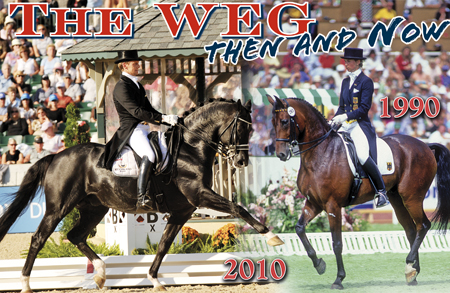
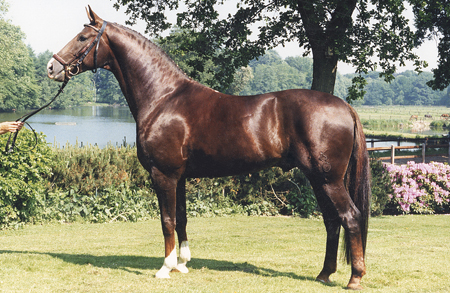
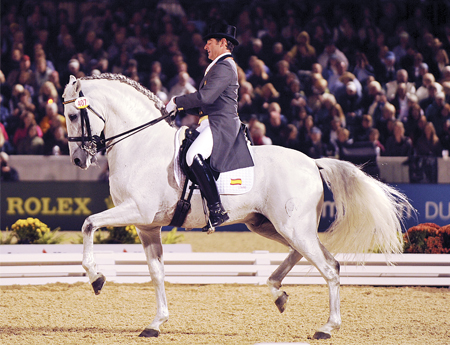
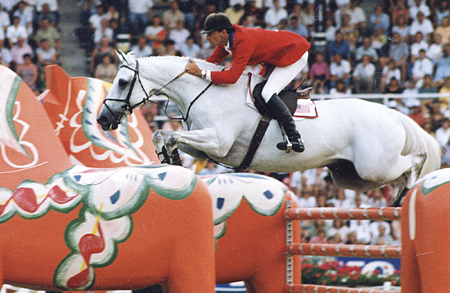
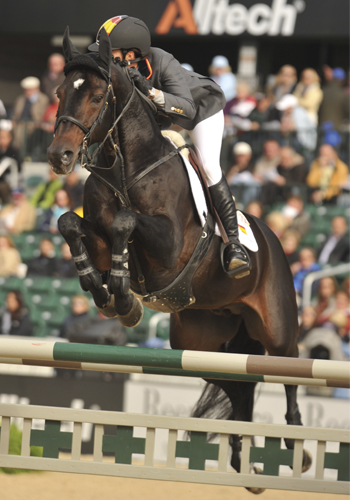
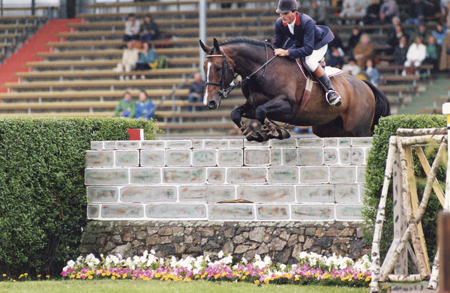
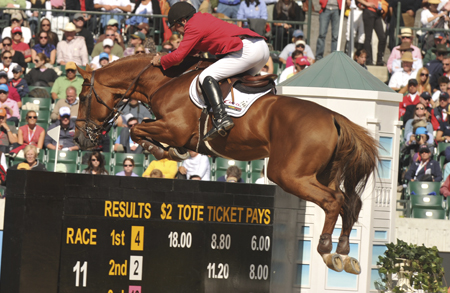
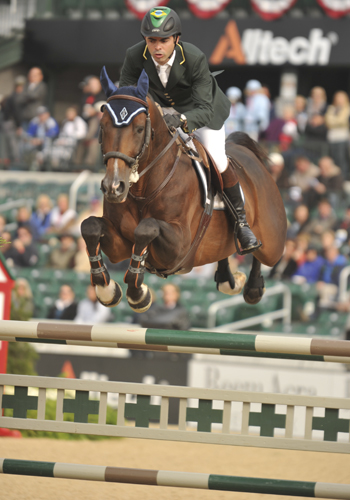
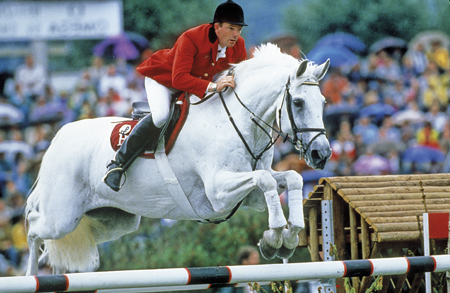
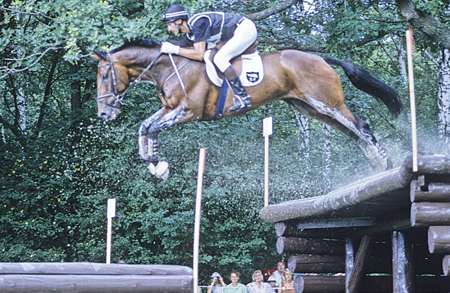
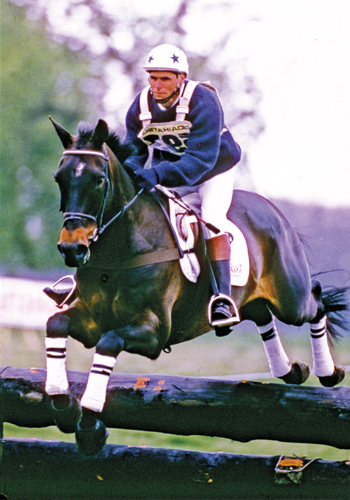
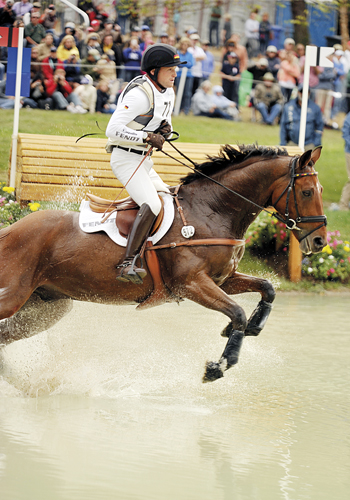
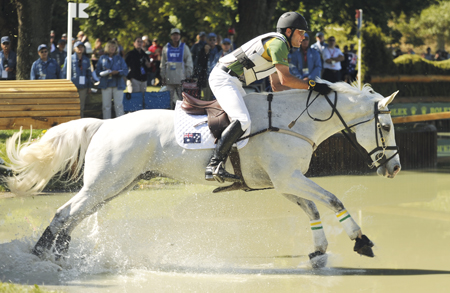
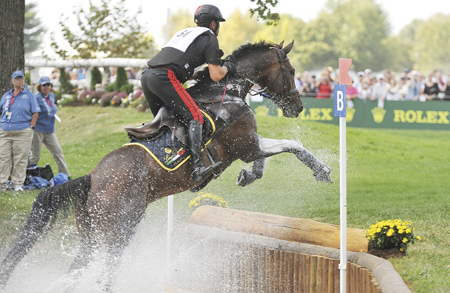
I am a thoroughbred man who has trained and liked most warmbloods even one trakhener I am 6’2′ tall and have been dubbed a natural by some pretty hefty trainers and riders….I began riding jumpers bareback when I was 14 formal lessons by( the captain of the us cavalry team in the 40’s) who first called me a nautral came when I was 30 yrs old(late bloomer) then a list of great trainers were under my belt and great horses along the way many thanks to my mentors and the horses and those who trusted me to ride and train their elite stock I f I listed the names of my teachers most people say WOW and some say did he ever pay you? when I mention one I rode and trained for ( who cared he put me on world class horses and never questioned my approach to young stock and he praisesd me to the point of embarrassment initals JF) bob egan gave me his saddle after letting me school a jumper on his farm the one he rode for many years what a joy he was to have critique my riding horses are my love (ask my kids) I see some interesting horses in video and photos from a farm in the usa I am prepared to devote time and effort to their development in a syndicate; mares are key my wish list of mares I have put out to the public and I am sure they are pricey the longer (the stirrups)the longer you ride I am saddling up at 70 and get goose bumps just waiting to get on that new special jumper I think I have found who some think is an ugly duckling I think she is a swan in waiting!! ask me in a month after I get on her once!!! it is all about the feel even on an 18.2 hand trakhener or an 18.2 selle francais or a 14.2 arab that jumps the moon!